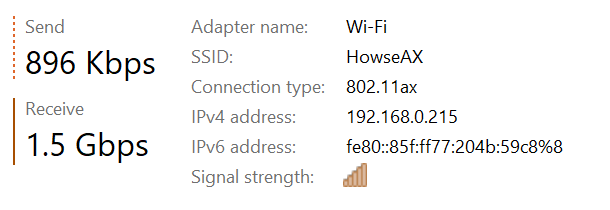AT 101: Wi-Fi 6 And Why You Want It
by Brett Howse on February 12, 2020 8:00 AM ESTTo The Future
If the question is do you need Wi-Fi 6, the answer is most assuredly “maybe”. The performance improvements are substantial, but really rely on a very strong signal to get the most data throughput. Most of the new features of Wi-Fi 6 focus on the influx of devices to the standard, and dealing with many devices connected to the same access point, or devices trying to share spectrum when connected to different access points.
The addition of Orthogonal Frequency Division Multiple Access to the Wi-Fi 6 standard will likely be the most impactful change to this revision. It will allow access points to carve up their channels into smaller slices, allowing more devices to communicate at the same time with less overhead. Each device will lose out on peak throughput, but the reduced latency should help a lot, especially in very dense environments. It should help with excessive overhead on the network layer when multiple devices are sending many small packets at once, which is a very common scenario, especially in an office or stadium situation.
Multi-User MIMO was in the Wi-Fi 5 specification as an optional implementation, and as such it did not really take off. Wi-Fi 6 should make this more prevalent, and also adds support to the MU-MIMO on the uplink, not just the downlink side. This will increase the capacity of access points for higher-speed use cases, but MU-MIMO did not get a lot of traction in Wi-Fi 5 so we will have to see how much adoption it gets in Wi-Fi 6.
The wider 160 MHz channels will offer significantly more throughput in the home environment, as we saw in our performance tests. As with the 1024-level QAM though, to see the biggest benefit you will need a strong signal. The vast majority of home networking is still limited to 1 Gigabit Ethernet, which puts Wi-Fi 6 into somewhat of an awkward spot, since it can transfer faster than most wired home networks, but even so, that is still a significant improvement over Wi-Fi 5 which would cap out around 600 Mbps on the best Wi-Fi adapters. If you work with a lot of large files, and you prefer to use Wi-Fi instead of the more consistent, yet cumbersome Ethernet, there’s still a nice boost to be had.
The future looks strong for Wi-Fi, and the Wi-Fi Alliance has made some excellent revisions to their standard to help improve Wi-Fi for the next generation of devices. As with any standards change, the impacts will not be seen right away. Both the access point, and the client need to be leveraging the new standard for the improvements to be noticeable. We’ve already seen the latest generation of smartphones start to offer Wi-Fi 6, and there’s been some movement in the PC space as well with Intel’s Project Athena. Anyone looking at a new router today should certainly opt for a Wi-Fi 6 model, but there’s likely not a major need for most people to move from Wi-Fi 5 access points right away. If you live in a heavily congested wireless area, the advantages of features like BSS coloring and Spatial Frequency Reuse should help out in those scenarios, but for people looking at purely performance, Wi-Fi 6 somewhat runs into a wall of its own making, since it can now transfer at over Gigabit speeds on a typical 2x2:2 connection. But who are we to question performance?












149 Comments
View All Comments
ksec - Wednesday, February 12, 2020 - link
Not only that. ( OFDMA It has compatibility problems and remains to be seen whether it works given the limitation ) It will likely end up like MU-MIMO where the benefits drops once you have non-MU-MIMO devices in the same location. ( i.e useless )160Mhz and 80+80Mhz are still optional. Meaning you wont get those sort of speed in vast majority of cases, no current 802.11ax Smartphone support 160Mhz or 80+80Mhz Channel. ( Both Samsung and iPhone ) Although Intel ( if I remember correctly ) do support 160Mhz, but then they decided to stop making 3x3 config for Laptop.....
WiFi 6E had the best chances to remedy all of this. But nope, all those features are still optional.
There were a few other features missing from the spec, oh I forgot to mention the spec is still in Draft as it has been delayed yet again.
The whole thing is a bloody pile of mess.
PaulHoule - Wednesday, February 12, 2020 - link
My experience with WiFi performance in the real world is that nothing beats having multiple access points and spreading the clients between them. Performance is just so much better when clients aren't fighting each other for access to the net, and this counts particularly for internet connections to the outside, where the most important WiFi parameter is packet loss.I am waiting for UNBT to come out with a WiFi 6 access point which is reasonably priced, and for that matter, to get any cliets that support WiFi 6.
digitalgriffin - Wednesday, February 12, 2020 - link
True Paul. I segment my network. I have a subnet for smart devices with it's own AP running on a unique frequency. I have another subnet for my streaming devices with it's own AP. It not only allows me to save bandwidth for more critical devices, but also allows me to monitor on a more granular level for data usage and potential hacking hijinx.The only disadvantage to this method is my android devices can no longer directly access devices like Roku.
imaheadcase - Wednesday, February 12, 2020 - link
This article is so silly.First the title says "why you want it". Then later it says "maybe". Then it shows "benchmark" for unrealistic speeds, with limited devices to test.
Then it totally glosses of the fact that its not worth it AT ALL if other devices are not the same spec.
Considering %99 of devices that come out are 2.4Ghz still, including top of the line cameras zero reason to upgrade to this.
I'm thinking the article was just put up for the ad revenue for the clicks.
Oh lets not even go over how they talk about the progression of the wireless standard that takes forever to ratify, it its speeds are still really weak when it comes to LAN.
Unless you live in an area impossible to wire with LAN, no reason to go wireless. I'm my experience in a PoE camera is even better than wireless camera setup!
PeachNCream - Wednesday, February 12, 2020 - link
Yes, the article title is was poorly thought out to say the least. I'd prefer if the facts were presented as facts and the decision about whether or not I wanted something would reside in opinions I form after the fact. Telling me I want something is somewhat narrow thinking.GreenReaper - Friday, February 14, 2020 - link
This is a problem with the whole "thought leader" aspect of journalism. At least they could leave open the possibility that you might *not* want it. Right now, on the face of it, that's not an option.Dug - Wednesday, February 12, 2020 - link
What does some walls mean? Can you please tell us how many walls, what kind of wall, height of ceiling, and the distance? In my mind you are saying that you are 3 rooms away? How big are the rooms? Or is it a hallway wall without doors?If you are going to have a "test bed" it would be nice to know the layout so we can judge if it matches our environment.
Thanks.
DanNeely - Wednesday, February 12, 2020 - link
agreed. Arstechnica posts floorplan diagrams for their wifi testing articles; which comes in particularly useful for testing mesh network kits with variable numbers of boxes.ascott.neu.edu - Wednesday, February 12, 2020 - link
how does dynamic fragmentation work? i.e, are packets reassembled before being sent to the internet, or are the fragments reassembled at the destination? most systems try to avoid fragmentation, as it requires reassembling packets, and actively try to identify the largest packet that can be sent without fragmentation. dsl usually required smaller packets to avoid fragmentation, as i recall. Gigabit "ethernet" is switched. no interference from others using the same network. store and forward, almost always delivers packets. wifi is more old school csma/ca, which isn't even as good as old fashioned csma/cd ethernet. collisions detected in hardware rather than waiting for ack/nak. No matter how fast your wifi is, there are still shared resources that may very well limit your throughput and latency to resources on the internet.damianrobertjones - Wednesday, February 12, 2020 - link
"Wi-Fi 6 And Why You Want It"I don't actually want this.